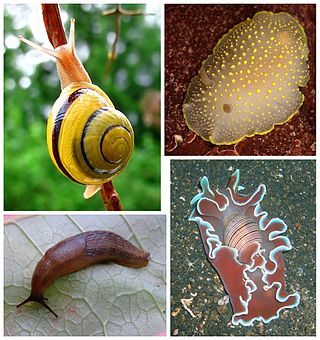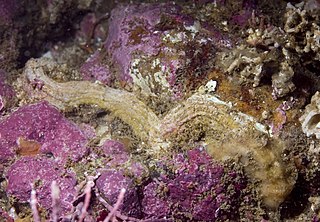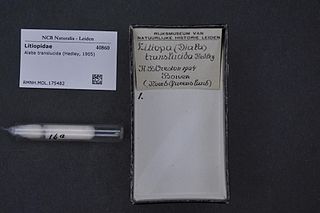
Neogastropoda is an order of sea snails, both freshwater and marine gastropod molluscs.

Orthogastropoda was a major taxonomic grouping of snails and slugs, an extremely large subclass within the huge class Gastropoda according to the older taxonomy of the Gastropoda.

Heterobranchia, the heterobranchs, is a taxonomic clade of snails and slugs, which includes marine, aquatic and terrestrial gastropod mollusks.

Sorbeoconcha is a taxonomic clade of snails, i.e. gastropods, mainly marine species with gills and opercula, within the clade Caenogastropoda.

Hypsogastropoda is a clade containing marine gastropods within the clade Caenogastropoda.

Littorinimorpha is a large order of snails, gastropods, consisting primarily of sea snails, but also including some freshwater snails and land snails.

The Aciculidae are a family of minute land snails which have opercula. In other words, Aciculidae are terrestrial operculate gastropods. Even though Aciculidae are land snails, they live in rather wet conditions, among mosses and dead leaves and they have sometimes been described as "winkles come ashore".

The Vermetidae, the worm snails or worm shells, are a taxonomic family of small to medium-sized sea snails, marine gastropod molluscs in the clade Littorinimorpha. The shells of species in the family Vermetidae are extremely irregular, and do not resemble the average snail shell, hence the common name "worm shells" or "worm snails".
The taxonomy of the Gastropoda as it was revised in 2005 by Philippe Bouchet and Jean-Pierre Rocroi is a system for the scientific classification of gastropod mollusks. The paper setting out this taxonomy was published in the journal Malacologia. The system encompasses both living and extinct groups, as well as some fossils whose classification as gastropods is uncertain.
The taxonomy of the Gastropoda, as revised by Winston Ponder and David R. Lindberg in 1997, is an older taxonomy of the class Gastropoda, the class of molluscs consisting of all snails and slugs. The full name of the work in which this taxonomy was published is Towards a phylogeny of gastropod molluscs: an analysis using morphological characters.

Vetigastropoda is a major taxonomic group of sea snails, marine gastropod mollusks that form a very ancient lineage. Taxonomically the Vetigastropoda are sometimes treated as an order, although they are treated as an unranked clade in Bouchet and Rocroi, 2005.
Winston Frank Ponder is a malacologist born and educated in New Zealand who has named and described many marine and freshwater animals, especially micromolluscs.

Neritimorpha is a clade of gastropod molluscs that contains around 2,000 extant species of sea snails, limpets, freshwater snails, land snails and slugs. This clade used to be known as the superorder Neritopsina.

The Cerithioidea is a superfamily of marine, brackish water and freshwater gastropod containing more than 200 genera. The Cerithoidea are included unassigned in the subclass Caenogastropoda. The original name of this superfamily was Cerithiacea, in keeping with common superfamily endings at the time.

Architaenioglossa is a taxonomic group of snails which have gills and often an operculum. They are primarily land and freshwater gastropod mollusks within the clade Caenogastropoda.

Pachychilidae, common name pachychilids, is a taxonomic family of freshwater snails, gastropod molluscs in the clade Sorbeoconcha.

Dialidae, common name dialids, is a family of sea snails, marine gastropod molluscs in the clade Sorbeoconcha.

Litiopidae, common name litiopids, is a family of small sea snails, marine gastropod molluscs in the clade Sorbeoconcha.
This overview lists proposed changes in the taxonomy of gastropods at the family level and above since 2005, when the taxonomy of the Gastropoda by Bouchet & Rocroi (2005) was published. In other words, these are recent updates in the way various groups of snails and slugs are classified.
Obtortionidae is a family of sea snails, marine gastropod molluscs in the superfamily Cerithioidea, that is within the clade Cerithimorpha or in clade Sorbeoconcha.















